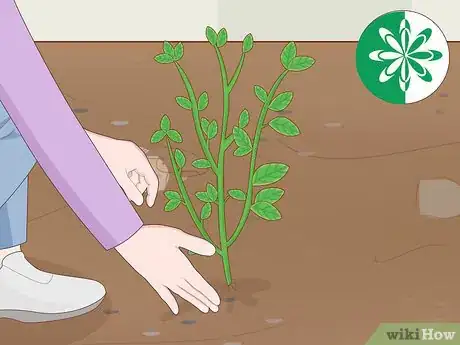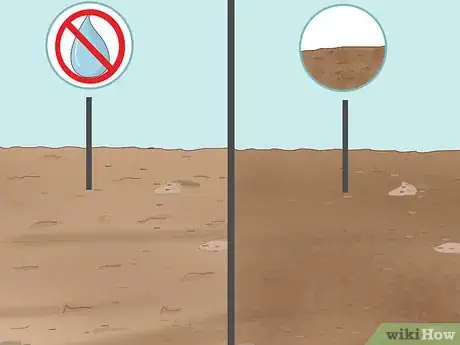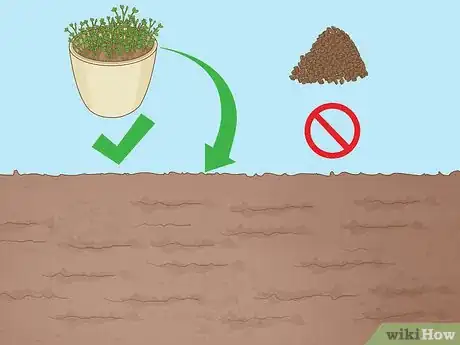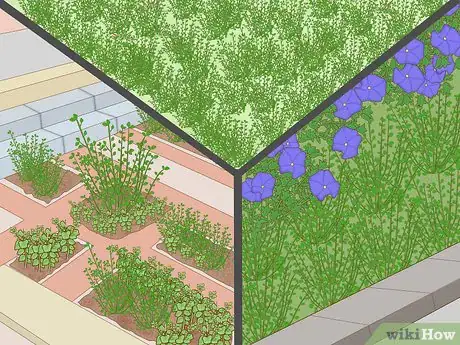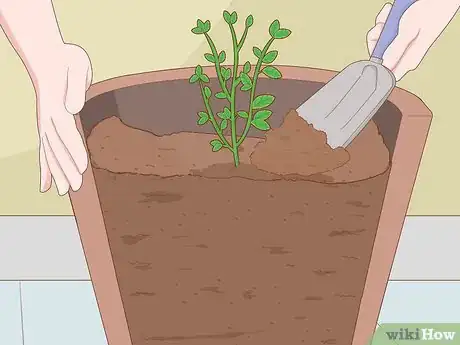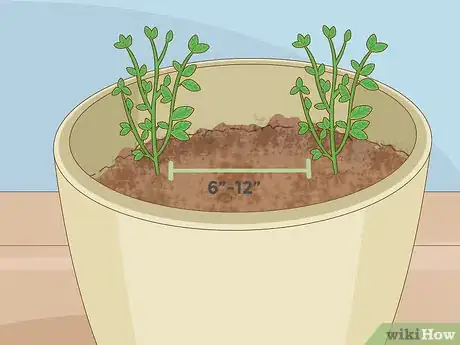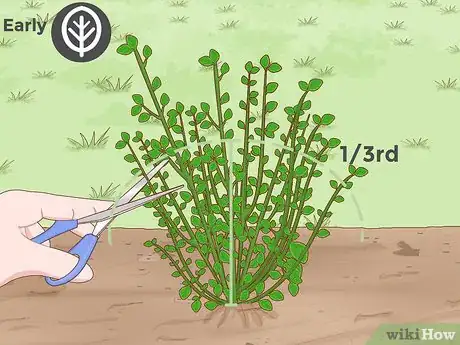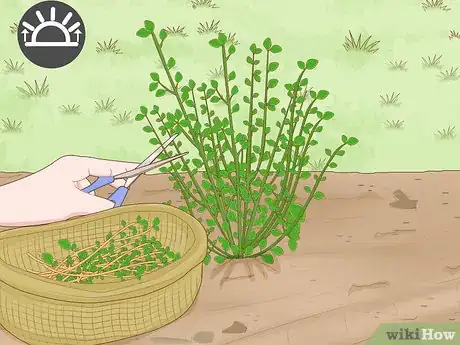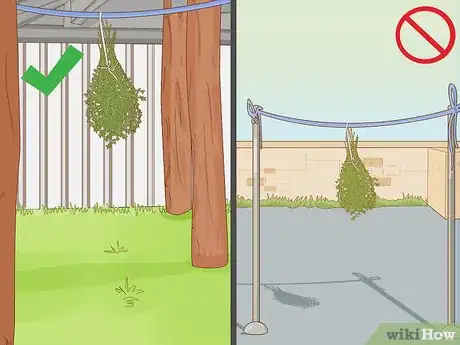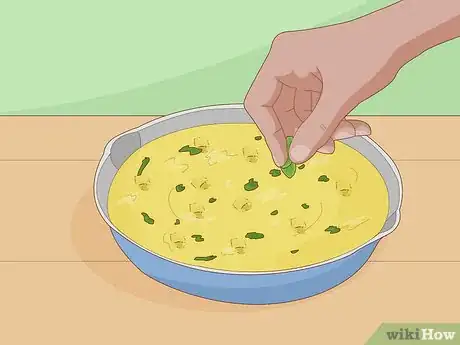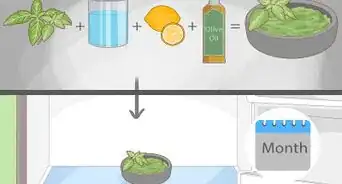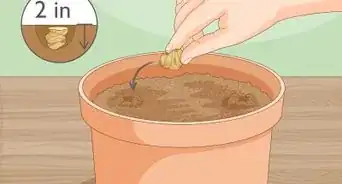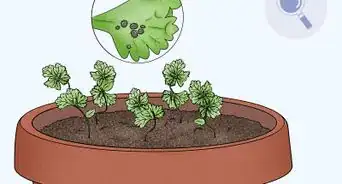This article was co-authored by Lauren Kurtz. Lauren Kurtz is a Naturalist and Horticultural Specialist. Lauren has worked for Aurora, Colorado managing the Water-Wise Garden at Aurora Municipal Center for the Water Conservation Department. She earned a BA in Environmental and Sustainability Studies from Western Michigan University in 2014.
There are 7 references cited in this article, which can be found at the bottom of the page.
This article has been viewed 42,626 times.
Lemon thyme is an easy plant to grow and it makes a great addition to any herb garden! This herb has a beautiful, lemony flavor that pairs nicely with many different dishes. Pick bright, healthy plants to grow and choose a sunny spot with well-drained soil for planting. Care for lemon thyme by watering it occasionally and trimming it each year to encourage new growth. You can use your lemon thyme fresh in soups or stews, or hang it up to dry.
Steps
Choosing the Right Time and Location
-
1Grow lemon thyme in hot and dry climates. Lemon thyme thrives in climates that are warm and don't have frequent heavy rainfall. If you are unsure about if your area has the right climate for lemon thyme to thrive, ask at your local gardening center.[1]
- Lemon thyme copes much better with drought than with too much rain or cool temperatures.
- USDA hardiness zones 5-9 are suitable for growing lemon thyme.
-
2Plant lemon thyme in the spring. The best time to plant lemon thyme is during the growing season and when the threat of frosts has passed. Wait until the start of spring to begin planting lemon thyme and avoid planting it during fall or winter.[2]Advertisement
-
3Choose a planting spot that gets at least 6 hours of sunlight each day. Lemon thyme does best in areas with full sun! Look around your garden before you begin planting and notice which areas receive the most sun. Ideally, choose an area that doesn’t have any large plants nearby which may cause shade.[3]
-
4Pick an area with well-drained soil to prevent root rot. Lemon thyme thrives in well-drained soil. Pick a spot that has relatively dry, loosely packed soil, as this type of soil drains well. Avoid planting lemon thyme in areas of stagnant water or where the soil is very compact.[4]
- Root rot and mold can be particularly damaging to lemon thyme in very humid or damp climates.
- You can improve soil drainage by mixing bark, wood chips, compost, or pea gravel into the soil.[5]
- The ideal soil pH for lemon thyme is between 6.5 and 8.5. The large majority of garden soils are suitable.[6]
Planting Lemon Thyme
-
1Get bright, healthy thyme plants to grow. Look around at the lemon thyme plants at your local gardening center and choose only the healthiest plants. Look for plants with bright leaves and new growth that aren’t too woody. Healthy plants aren’t necessarily the tallest, but instead are dense, fragrant, and may even have flowers.[7]
- It’s recommended to grow lemon thyme from plants rather than from seeds.
-
2Plant lemon thyme in the ground for unrestricted growth. Whether you want to create a herb garden, a flower border, or a dense ground cover, lemon thyme does well! The ground or a garden bed is an ideal place for lemon thyme if you don't plan to transfer it.[8]
- Ensure that you check that the soil is dry and well-drained before you plant lemon thyme in the ground.
-
3Choose a 6 in (15 cm) deep container if you want to limit growth. Lemon thyme also grows well in containers, both indoors and outdoors. Pick a container that is the size you would like the lemon thyme to grow to and make sure that it has a depth of at least 6 in (15 cm). Plastic or terra cotta containers work well.[9]
- Gardening centers and department stores sell a wide range of different planting pots.
- You can plant multiple lemon thyme plants in 1 container provided that each plant has enough space.
- Keep in mind that you will need to move the pot indoors, such as in a shed or garage, or bury the pot in the ground, to provide some protection from harsh winter weather. Freezing and thawing cycles are likely to crack the pot and kill the plant.
-
4Dig a hole just deeper than the root system to plant lemon thyme. Once you have picked the right spot and chosen your lemon thyme, it's time to start digging! Get a shovel or a trowel and begin digging into the soil. Dig a hole that is just slightly deeper than the container the lemon thyme is currently in, as this ensures that there will be enough space for the whole root system.[10]
- The hole doesn't need to be any wider than the lemon thyme plant. Use the container that the plant is in as a guide for approximately how big the hole should be.
-
5Suspend the plant in the hole and carefully fill it up with soil. Gently squeeze the sides of the container and lift the lemon thyme out. Hold the lemon thyme in the hole and gently fill it up with soil, taking care not to break any roots. Fill the hole up to just above the crown of the plant.[11]
- Make sure that you fully support the plant until it's supported by the soil.
- The crown of the plant is where the woody stem meets the root system.
-
6Space out lemon thyme plants by 6–12 in (15–30 cm). How far apart you space the lemon thyme plants depends on the type of cover you are aiming for. If you want the plants to form a dense ground cover, place each individual plant 6 in (15 cm) apart. Alternatively, if you are wanting the plants to grow separately and not form ground cover, space each plant out by at least 12 in (30 cm).[12]
- Lemon thyme plants tend to grow 12–15 in (30–38 cm) tall.
Maintaining and Harvesting Lemon Thyme
-
1Water lemon thyme lightly whenever the soil feels dry. It’s important to only lightly water the soil to avoid causing it to become saturated, as lemon thyme thrives in mostly dry soil. Whether you have planted the lemon thyme in the ground or in a container, check the soil regularly and if it feels dry give the plants a light water with the hose or a watering can.[13]
- Lemon thyme is relatively easy to care for provided that you don’t overwater the soil.
-
2Trim lemon thyme in early spring to encourage new growth. Take a pair of clean gardening shears and trim each plant back by approximately 1/3. Always cut just above the points of new growth so that the plant stays healthy and strong. Never cut the plant at the leafless, woody stem, as this can cause damage.[14]
- Trimming the lemon thyme encourages new leaves to grow and prevents the plant from becoming woody.
- If you want to shape the plant after it has been trimmed, wait until just after it has stopped flowering.
- If there are any dead branches, remove these at the start of spring.[15]
-
3Harvest lemon thyme during the morning for the strongest aroma and flavor. Either pluck individual leaves off the lemon thyme plant if you only need a few or use clean gardening shears or scissors to cut off a couple of leafy stems. If you want to harvest the flowers for decoration or garnishes, wait until spring.[16]
- Lemon thyme is evergreen, which means that you can harvest it at any time during the year.
-
4Hang lemon thyme to dry if you aren't going to use it fresh. Although lemon thyme is best used fresh, it can be dried if you prefer. Take the sprigs that you need and rinse them in cool water. Then shake the sprigs gently to get rid of any excess moisture and tie them in bundles of 4-6. Hang the bundles upside down in a cool, dark location to dry and keep them out of direct sunlight.[17]
- Once the lemon thyme has fully dried, place the leaves into an airtight container.
-
5Use lemon thyme leaves to add a lemon flavor to your savory dishes. Lemon thyme is a great herb to add to a variety of dishes. Finely chop the leaves and add them to the dish just before serving to retain the strong aroma and flavor. Try lemon thyme in soups or stews, or added to seafood, vegetable, and poultry dishes for a bit of zing![18]
- You can also garnish prepared dishes with fresh lemon thyme flowers or sprigs.
- Lemon thyme is best used fresh rather than dried.
Expert Q&A
-
QuestionAre flowers edible on lemon thyme?
 Lauren KurtzLauren Kurtz is a Naturalist and Horticultural Specialist. Lauren has worked for Aurora, Colorado managing the Water-Wise Garden at Aurora Municipal Center for the Water Conservation Department. She earned a BA in Environmental and Sustainability Studies from Western Michigan University in 2014.
Lauren KurtzLauren Kurtz is a Naturalist and Horticultural Specialist. Lauren has worked for Aurora, Colorado managing the Water-Wise Garden at Aurora Municipal Center for the Water Conservation Department. She earned a BA in Environmental and Sustainability Studies from Western Michigan University in 2014.
Professional Gardener Yes, the flowers and the leaves of lemon thyme are edible.
Yes, the flowers and the leaves of lemon thyme are edible. -
QuestionShould you water the thyme directly onto the dirt or in the saucer?
 NinoxTop AnswererWater directly onto the dirt. If you water in the saucer, the water won't ascend if the soil is draining.
NinoxTop AnswererWater directly onto the dirt. If you water in the saucer, the water won't ascend if the soil is draining. -
QuestionWe had it growing in one place, we pulled them up to bring them home. How do we replant them?
 NinoxTop AnswererYou have to choose a sunny place to plant it. Then put some sand in the hole and place the thyme into it. You need to water the plant the first year in its new place to stimulate the roots.
NinoxTop AnswererYou have to choose a sunny place to plant it. Then put some sand in the hole and place the thyme into it. You need to water the plant the first year in its new place to stimulate the roots.
Things You'll Need
- Lemon thyme plants
- 6 in (15 cm) deep container
- Shovel or trowel
- Watering can or hose
- Gardening shears or scissors
References
- ↑ https://www.gardeningchannel.com/how-to-grow-lemon-thyme-thymus-citriodorus/
- ↑ https://www.gardeningchannel.com/how-to-grow-lemon-thyme-thymus-citriodorus/
- ↑ https://www.gardeningchannel.com/how-to-grow-lemon-thyme-thymus-citriodorus/
- ↑ https://www.gardeningchannel.com/how-to-grow-lemon-thyme-thymus-citriodorus/
- ↑ https://articles.extension.org/pages/61063/materials-to-improve-drainage-in-soil
- ↑ http://herbgardening.com/growingthyme.htm
- ↑ https://www.finegardening.com/article/six-superb-herbs-for-containers
- ↑ https://www.finegardening.com/article/six-superb-herbs-for-containers
- ↑ https://harvesttotable.com/how_to_grow_thyme/
- ↑ https://www.finegardening.com/article/six-superb-herbs-for-containers
- ↑ https://www.finegardening.com/article/six-superb-herbs-for-containers
- ↑ https://www.gardeningchannel.com/how-to-grow-lemon-thyme-thymus-citriodorus/
- ↑ https://www.gardeningchannel.com/how-to-grow-lemon-thyme-thymus-citriodorus/
- ↑ https://www.gardeningchannel.com/how-to-grow-lemon-thyme-thymus-citriodorus/
- ↑ https://www.nature-and-garden.com/gardening/lemon-thyme.html
- ↑ https://www.gardeningchannel.com/how-to-grow-lemon-thyme-thymus-citriodorus/
- ↑ https://happymoneysaver.com/drying-herbs-first-time/
- ↑ https://www.gardeningchannel.com/how-to-grow-lemon-thyme-thymus-citriodorus/

